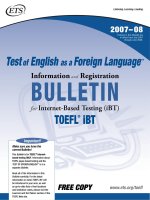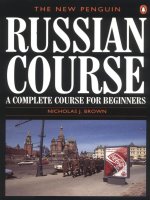A laboratory Guide for beginners in Zoology, Moores and Crossman, 1902
Bạn đang xem bản rút gọn của tài liệu. Xem và tải ngay bản đầy đủ của tài liệu tại đây (9.71 MB, 131 trang )
A LABORATORY GUIDE
'
FOR BEGINNERS
ZOOLOGY
IN
BY
CLARENCE MOORES WEED,
D.Sc.
AND
RALPH WALLACE CROSSMAN,
t
'
i
3
3
3
3
)
33333
3
J
jjc3o
-
t
-
BOSTON,
C HEATH &
^3>
33
3
>
Io '
"»
»
*
>J
3
3
3
>:
*°
D.
A.B., M.Sc.
3
3
','
3
,
3
>
3
J
o
\3
^
3»*
'''I
o
J
3, 9
S
.
',
) )
>>
U.S.A.
CO, PUBLISHERS
1902
T
5
-,
»,
,
'
>
- »
-3> »0' 3
THE LIBRARY OF
CONGRESS,
Two Cowsfi Received
SEP.
26 1902
COPVRWHT ENTWV
CLASS <^XXo
CO**
No.
s
Copyright, 1902,
By CLARENCE M.
and
WEED
RALPH W. CROSSMAN.
Plimpton press
H. M.
PLIMPTON
&.
CO..
PRINTEPS & BINDcRS,
NORWOOD, MASS., USA.
PREFACE
It
is
generally conceded that a satisfactory course in
zoology requires both laboratory study of animal forms
and lecture or text-book presentation
life.
The
teachers
of the laws of animal
most conversant with pedagogical
principles also contend that the greatest educational value
Qf the subject lies in the opportunity
the
student with
it
gives to furnish
an adequate first-hand knowledge of
To accomplish
organic evolution.
this a course in
which
the pupil begins with the lower forms and works gradually
upward
is
necessary.
For the pupil thus follows the de-
velopment of living things, seeing how each succeeding
form
is
an improvement over the one that went before,
and getting some idea of the great laws which govern the
growth and sequence
of
animal
life.
In his study of these forms of
life
the pupil needs a
guide which shall lead him wisely without telling him too
much, and which
shall stimulate
him
to see
and
to think
without bewildering him with questions that he cannot
answer.
In this
little
book such an attempt
Since the directions were
first
used in
is
my own
made.
classes
some ten years ago modifications have been made every
year, until in their present
form
I
have found them thor-
oughly workable with average classes of beginners in
zoology.
Preface
iv
The
directions in the introductory chapter are designed
to help the teacher in getting material for study; they are
not intended for the pupil, although the figures should be
helpful in enabling the teacher to
show the
class
what
to
look for in the case of the microscopic specimens.
In the preparation of a few of the chapters valuable
assistance has been rendered
by Mr. Albert F. Conradi,
while the drawings have been
Cushman.
The
to Professor J.
authors are also under great obligations
H. Gerould of Dartmouth College, who has
kindly read the proof, and
tions for the
made by Mr. Robert A.
made many
valuable sugges-
improvement of the Guide.
C.
New Hampshire College
of
Agriculture and Mechanic Arts,
Durham,
August, 1902.
M. W.
.
CONTENTS
PAGE
INTRODUCTION
iii
The Laboratory and its EquipmentThe Cultivation and Preparation of Material
ix
xi
CHAPTER
I.
BRANCH PROTOZOA: The
The Amoeba
The Euglena
The Paramecium
The Vorticella
The Stentor
The Stylonychia
The Classification
One-celled Animals
3
5
8
9
.
II.
io
of the Protozoa
12
BRANCH PORIFERA: The
Sponges
The Fresh-water Sponge
The Marine Sponge
The Classification of the Porifera
15
....
15
16
18
.
III.
BRANCH CCELENTERATA
ANExMONES
The
The
The
The
The
IV.
:
The Hydras and Sea
20
.
Fresh -water Hydra
20
Campanularian Hydroid
23
Hydro-medusa
Tubularian Hydroid
26
Classification of the Ccelenterata
29
27
BRANCH TROCHELMINTHES The
:
Rotifers and
their Allies
The
The
I
I
.
Rotifer, or
31
Wheel Animalcule
Classification of the Rotifers
and
.
.
their Allies
31
.
.
.
^
Contents
vi
PAGE
CHAPTER
V.
BRANCH ECHINODERMATA: The
Starfishes and
Sea-urchins
35
The Starfish
The Sea-urchin
The Sea-cucumber
The Classification of the Echinodermata
VI.
40
...
BRANCH ANNULATA: The True Worms
The Earthworm
The Marine Annelid
The Classification of the Annulata
.
VII.
35
BRANCH
.
.
ARTHROPODA:
.
.
.
44
46
.
.46
.
.
42
....
.....
The Wood-louse, or Sow-bug
The Lobster, or Crayfish
The Crab
The Cyclops
The Flattened Centipede
The Locust, or Grasshopper
The Dragon-fly
The Butterfly
The Spider
The Classification of the Arthropoda
Snails
IX.
62
64
65
71
....
72
74
Oyster, Clams, and
77
77
82
83
of the Mollusca
BRANCH CHORDATA: The
The Perch
The Frog
The Bird
The Classification
53
68
.
The Clam
The Snail
The Squid
The Classification
53
54
60
......
BRANCH MOLLUSCA: The
52
The Animals with
Jointed Legs
VIII.
49
85
Vertebrates
.
.
87
87
.
92
98
of the Vertebrates
.
.
.
.
102
INTRODUCTION
THE LABORATORY:
EQUIPMENT AND THE
PREPARATION OF MATERIAL
ITS
_u^
Fig.
i.
A
Movable Laboratory Table.
vm
INTRODUCTION
THE LABORATORY AND ITS EQUIPMENT
The zoological laboratory should be a well-lighted room,
with sufficient space for each student to work comfortably.
When
possible it is better not to have direct sunshine
through the windows during the hours of work.
The laboratory must be fitted with some form of desks
or tables, at which the student can work with ease. When
were not available, I have
found individual tables, like the one shown in Figure I,
fairly satisfactory, especially for rooms which cannot be
permanently fitted up with more expensive desks. Such
tables have many advantages.
On the one hand they are
readily movable, so that the space can be divided according to the size of the class, no more desks being kept in
the room than are needed for use they are made of different heights, so that they can be adapted to individual stugood-sized laboratory
tables
;
dents
light
they may be shifted about as
may demand they enable the
;
;
the conditions" of the
teacher to insist that
each student shall work alone, without assistance from
others
others
desk.
;
and they prevent the joggling of the microscope of
when
On
a pupil uses the eraser, or
is
restless at his
the other hand, they are liable not to rest
squarely upon the floor
become worn through
if
it
is
not carefully
laid,
or has
and in the form I have used
there is no drawer in which to keep appliances.
The
addition of a drawer would render them more useful.
use,
x
Introduction
The desk
high, and
board
a
is
is
illustrated in the figure is twenty-seven inches
made
of pine boards, one inch thick
;
the top
eighteen inches wide by thirty-two inches long.
Whenever possible, each pupil should be provided with
compound microscope, magnifying to about five hundred
diameters.
There
are,
of course,
many forms
of micro-
In selecting them, the aim must
scopes to choose from.
generally be to get the best instrument for the least money.
my own
have used with satisfaction the
Leitz Stand No. 2, with objectives 3 and 7 and eye-pieces
1
and 3, an outfit costing $17 when imported duty free.
The stand has no rack and pinion adjustment, but it
Similar simple forms of
serves its purpose admirably.
American makers will probably prove equally satisfactory,
and there should be no difficulty in getting a microscope
suitable for work in elementary zoology at the price named.
If the pupils have not before used the compound microscope, a preliminary exercise should be given before the
work in zoology is taken up. An excellent guide to such
an exercise will be found in Dr. Charles H. Clark's " Practical Methods in Microscopy," in which there are also given
plain directions for preparing the few staining solutions
In
laboratory
I
called for in this manual.
A
few glass
glasses are
slides,
cover glasses, and two or three watch
necessary for each desk.
A
pair of small,
sharp-pointed scissors, forceps, and scalpel are also needed,
as well as a shallow tray or dish for the dissections that
are to be done under water.
Shallow pans of granite-ware,
with sheet cork
embedded on the bottom
serve very well
;
but the wax-lined dissecting trays
the market are the best of
The
"
now on
all.
teacher should be provided
Text-book of
in plaster of Paris,
with the
Zoology," by Parker and
admirable
Haswell, the
Introduction
classification of
which
is
xi
followed in this guide, and should
have for reference as many other books on the subject as
Among the more important of these, mention
possible.
may be made of the following
:
Thomson's
"
—
Study of Animal Life."
"The Riverside Natural History."
"The Cambridge Natural History."
Claus's " Text-book of Zoology."
Lang's "Text-book of Comparative Anatomy."
McMurrich's " Invertebrate Morphology."
Packard's " Text-book of Entomology."
Comstock's " Manual for the Study of Insects."
Parker's " Elementary Biology."
Hertwig's " General Principles of Zoology."
Jordan and Kellogg's " Animal Life."
Jordan and Heath's " Animal Forms."
very desirable that some book should be studied
It is
by the
class as a text-book to
supplement the knowledge
obtained through the laboratory study.
THE CULTIVATION AND PREPARATION OF MATERIAL
Perhaps the greatest
difficulty that confronts the inexpe-
rienced teacher of zoology
rial
be studied, in
to
condition
method
for
class
is
found
sufficient
use.
in obtaining the
quantity
Success
with
and
the
in
perative that the organism selected should be on
this,
however,
taken up
times,
is
no light task.
in a certain definite
The
good
laboratory
of instruction in biological subjects renders
the right conditions and at the right time.
mate-
it
hand
imin
To accomplish
subjects are to be
order and at certain definite
and the specimens studied,
to
be of the most value,
Introduction
xii
must show the different phases of their growth. In those
cases where the organisms are sufficiently abundant in the
outer world to be available in quantity, it seldom happens
that they present the desired phases of their existence at
the time
when
it
is
necessary to study them.
In a large
proportion of cases they are not sufficiently abundant out
of doors to be readily obtained in the needed quantity.
Fortunately these
difficulties
may
to a great extent
be
overcome by indoor culture of the organisms required.
For several years I have been experimenting with such
cultures, and in the following pages I have summarized
such of the results as seem likely to be of assistance to
those
who
use this book.
The apparatus
required for such
simple and easily obtained.
For the aquarium
cultures, glass dishes and jars of almost any size and shape
may be used. Perhaps no one general form is so cheap
and satisfactory as the special aquarium jars recently
placed upon the market by the dealers in microscopes and
laboratory supplies.
These are of convenient size and
shape for cultures of many kinds, and a dozen or more of
them are of the greatest value to the work of any zoologiGlass covers for them should be purcal laboratory.
chased.
But in case these aquarium jars are not at hand,
wide-mouthed museum jars or beakers, or even fruit cans
and jelly glasses, will serve the purpose very well.
cultures
is
THE AMCEBA
Amoebae may be found in the waters of ponds and
ditches, but one is more certain to have them when wanted
Almost any of the
by providing aquarium cultures.
small aquaria described in these pages are likely to furnish
good amoebae, if one examines the sediment that gathers
on the sides or bottom of the vessel. I have often obtained
Introduction
THE AMCEBA:
A, B,
C,
shapes assumed with pseudopods extended;
£, shape when dividing. Magnified.
when encysted
;
Xlll
B, shape
Introduction
xiv
an abundance of fine specimens by placing small pieces
of bark from trees or pond sides in small aquaria.
After
the culture vessel has stood in a warm room two or three
weeks, remove the piece of bark from the water, and with
a fine brush scrape off on to a glass slide some of the
Frequently there will be dozens of
liquid adhering to it.
By floating a cover glass on
amoebae in a single mount.
the surface of the water of a jar containing amoebae and
kept in a diffuse light for a day or two, specimens may
be obtained free from sediment.
In studying the amoeba, one should not be content with
small amoeboid creatures having no contractile vacuole.
The large typical specimens showing contractile vacuole
and the nucleus may be obtained by a series of such
aquarium cultures as are here described. If the aquarium
is in a north window, it is well to put it in a warm sunny
situation a few hours before studying, as the amoebae thus
become much more active, and are of greater value for study.
With such specimens the vacuole may be seen to contract,
the distinction between the endosarc and the ectosarc may
be made out, the ingestion and egestion of food particles
may be observed, and my latest classes in zoology saw the
whole process of reproduction by fission.
The nucleus may be brought out in the amoeba by
staining with iodine, methyl green, or blue, and with various
other reagents.
dant
is
water in a culture jar in which amoebae are abunallowed slowly to evaporate, one will often be
able
to
get good
If the
encystment.
examples
to
If the jar is finally
illustrate the process of
allowed to become dry
and is then stored away, the culture may be started again
a method first suggested,
months later by adding water
I believe, by Professor Herbert Osborn.
—
Introduction
xv
THE EUGLENA
have generally been able to get the Euglena by this
place pieces of bark an inch or more square,
preferably from the edge of a pond, in the middle of a
beaker or jar holding a pint or more
I
method
:
Set the culture vessel in a
of water.
north window and
let
it
stand.
In a
few weeks examine the upper and under
surfaces of the pieces on the bottom,
and you are likely to find Euglena
viridis.
Euglenae are also likely to be found
on the sides and bottoms of many small
aquaria.
I have had fine lots of them
develop
in
closed
glass
plant
boxes,
which had been temporarily used for
In small salt-water
keeping frogs.
aquaria
containing
horse-shoe
crabs
they have also developed in great abundance-
The Green Euglena:
have also obtained a fine lot Of Active form. MagniEuglena viridis in this way
a glass
dish two inches high by six inches in diameter was twoI
:
thirds filled with vegetable debris
— largely pond, scum —
from an old spring. It was then filled with water, covered,
and placed near a window. After standing undisturbed
nearly two months, a thick whitish scum had developed on
top, and on the sides of the dish at the surface of the
water there was a green growth composed almost entirely
of euglenae.
In
'
summer and autumn
vicinity
of
barnyards
is
the
standing water
frequently full
of
in
the
euglenae in
Introduction
XVI
THE Paramecium: A
t
normal active form; B,
to bring out trichocyst threads
fission.
Magnified.
;
C,
after
treatment with acetic acid
conjugating specimens
;
D
t
early stage of
Introduction
excellent condition for study.
tion
may be
xvii
Water from such
a situa-
placed in jars indoors, and allowed to stand
some time with good
results.
THE PARAMECIUM
Paramecia may commonly be developed by putting an
excess of pond-scum or other water plants in a vessel
containing water and setting the vessel in a warm, dark
There will then probably be a whitish
closet for a week.
film on top of the jar; in this film you are likely to find
an abundance of paramecia.
Keep the jar in a warm,
dark situation and they will continue to develop for some
time.
One
of the finest lots of
paramecia
I
have ever seen
was developed in the following way a cylindrical jar
holding about two gallons (six inches wide by about fifteen
inches high) was nearly filled with water and then was
stocked with a mass of GEdogonium and other fresh-water
algae, obtained from a spring, October 22.
An excess
of this was put in, and the jar was placed in a well-lighted
room, six feet from a window. Five days later a rather
thick film had formed on the top it contained an abundance of large bacteria of various forms, a number of
ciliate and flagellate protozoa, a few desmids and diatoms,
:
;
:
as well as an occasional protococcus-like form.
of the jar
showed
bacteria,
The
sides
desmids, diatoms, Protococ-
and a few euglenae.
The bottom
showed an abundance of the same forms.
After this
examination (October 27) I covered the jar and put it
J
i
cus,
Haematococcus,
in a
dark
closet.
On November
1
another examination
was made.
The white film showed many ciliate infusoria,
including some fine paramecia.
Ten days later the water
Introduction
xviii
was
alive
with splendid examples of typical paramecia,
white in color, which showed plainly the details of structure.
Along the
sides of the glass, just
water, a white ring
was
below the surface of the
naked eye, which
visible to the
under the lens was seen to be composed entirely of these
paramecia, and the sides of the jar were also covered with
In many cultures since
colonies of Stentor polymorphns.
then I have obtained these rings of paramecia.
From
such rings, hundreds of specimens may easily be transferred
to the slide by means of a camel's-hair brush or a medicine
dropper.
Paramecia are also
aquaria
;
likely to
be found in many small
they are often abundant in those in which clams
have been kept. But they can be studied to much better
purpose when they are so abundant that one can have
the large typical specimens in quantity.
The course of the food-balls in the body may be admirplace a lot of paramecia in
ably shown by this method
a watch glass with a small quantity of water add a little
powdered carmine to the water cover, and examine fresh
specimens at intervals of ten minutes for an hour or more.
You will be able to trace the whole course of the food-balls
:
;
;
in this
way.
The nucleus
of
Paramecium may be brought out by
staining with iodine, magenta, methyl-green, or other stains.
The
trichocyst threads
may be brought
out by running
under the cover glass a dilute solution of osmic, picric, or
The form of the body is sometimes well
acetic acid.
shown when Schultze's
solution
is
added.
Paramecia should be first studied under the low powers
The normal shape
little or no cover-glass pressure.
can then be seen. The pressure of the cover glass flattens
By placing a little cotton-wool beneath the
the body.
with
:
Introduction
cover glass the movements
of
more
restricted so that they are
xix
the paramecia
may be
easily studied.
THE VORTICELLA
Vorticellae occur in nature in
but are
quantity for class
They may be
in
They
develop
kind,
ponds and sluggish streams,
such situations in sufficient
use.
diffi-
are likely
in
shallow
containing
dishes
aquatic
in
cultivated
aquaria without
culty.
to
find
to
difficult
plants
especially
of
if
any
the
dish be placed in a dark
In the aqua-
situation.
rium
which such a
in
great quantity of para-
mecia were developed,
as described above, large
numbers of
were
also
vorticellae
produced.
Several cultures of vorticellae
are desirable in
order to get the dividing, the
free-swimming,
and the encysted stages.
V
I
have repeatedly obTHE VORTICELLA
tained cultures showing
swimming form;
each of these forms, the
seeing of which adds
the class.
A
A, stalked form; B,
C,
encysted form.
free-
Mag-
nified.
much
to the value of the study
by
xx
Introduction
THE STENTOR AND STYLONYCHIA
Stentors are generally harder to develop in indoor cul-
common infusoria. But I have •usuallyhad them present in some one of the culture jars, frequentl)
Stylonychia is
in those in which paramecia are found.
also generally present in Paramecium cultures.
tures than the
SPONGES
Fresh-water sponges occur as bright green growths
attached to stones and wood in shallow streams. The
shade of the green is different from anything else in the
environment, and together with the distinct spongy feeling
of the
organism
will
enable any one to recognize
it.
It
frequently spreads over a considerable surface.
These sponges are common
in brooks,
be found in abundance in the
little
and may generally
pools between the
is rapid.
They should
be studied fresh, as they do not bear confinement in
standing water very well.
The gemmules occur late in
autumn.
large
stones
where the stream
The salt-water sponges are common along the coast,
and may easily be gotten from pools when the tide is out.
For inland schools they may be purchased of dealers in
biological supplies.
HYDRA
This creature has a small cylindrical body, by the base
which it attaches itself to various objects in the water,
and from the other end of which project a number of
tentacles.
Both the body and the tentacles are capable
of being expanded and contracted, so that sometimes they
of
Introduction
xxi
slender, and at other times short and
appearance when slightly magnified is
Two species are comshown in the figure herewith.
monly found in one the body is green in the other it
is light brown.
Hydras are common in ponds and ditches, but are
difficult to obtain in quantities under natural conditions.
are
and
long
Their
thick.
;
:
To
collect
them the following method
is
recommended
:
TxitT i t x t.o..yLUxrLaxLrtx
The Hydra.
Bring
in
streams
Magnified.
from various situations
small
Spirogyra, or
quantities
of
Vaucheria, —
in
ponds or sluggish
water-weeds,
collecting
— as
Nitella,
them with a small
quantity of water in jars or cans, and labelling each so as
to
know where
it
came from.
Place the material of each
collection in a jar of clear water near a
stand for a day or two.
window, and
Then examine
especially the sides near the window, for hydras.
a reading glass
is
very helpful.
let it
the jar carefully,
In this
In case hydras are found
Introduction
XX11
one jar, get more of the material from the same place
and treat it in the same way. The hydras may be trans-
in
ferred to covered aquaria containing Vaucheria, Nitella, or
where under favorable conditions they
and be available when wanted.
With a dozen or more aquaria containing water plants
in good condition in the
similar
plants,
will multiply
hydras
laboratory,
are
pretty sure to be present
in
some
Water
of them.
snails should not
lowed
in
clops
hydra
or
be
jars.
al-
Cy-
minute
other
Crustacea are also likely
to
be found
in
some
of
these jars.
Marine Animals,
— The
various marine forms
of in this book
treated
may
be
purchased
in
good condition for study,
at small expense, from
the Supply Department,
Marine Biological Laboratory,
Woods
as well
Holl, Mass.,
as from various
other dealers in such maCyclops.
Magnified.
terials.
INSECTS
It is of course necessary that insects should be collected
during the season when they are abundant. Some of them,
Introduction
like beetles,
alcohol
;
while others, like the
it,
collect
many
may
well be preserved in alcohol.
of the insects a net
obtain an iron wire about a
bend
it
may be preserved in
butterflies, may be kept dry,
grasshoppers, and crickets,
although part of these
To
xxiii
needed.
is
fifth of
To make
an inch in diameter,
into a ring about a foot in diameter, with the ends
projecting two or three inches at right angles; solder the
ends into a short piece of brass tubing.
Then sew over the
wire a strip of strong muslin an inch or two wide, and to
this
or
muslin sew a bag of mosquito netting, Swiss muslin,
some
similar fabric, about thirty inches deep.
in the field
ready to
make one beforehand
collect, cut a
that will
fit
When
handle for the net, or
into the piece of brass
tubing.
The most convenient method of killing insects is by the
To make this, take almost any
use of the cyanide bottle.
wide-mouthed glass bottle with a tight-fitting cork. Place
on the bottom two or three lumps of cyanide of potassium
(a virulent poison to be handled with great care), the size of
a hickory nut, cover these with fine sawdust, and over the
sawdust pour in sufficient plaster of Paris mixed with water
to make a layer half an inch thick.
Let the bottle dry out
before inserting the cork.
As already stated this cyanide
of potassium is poisonous, and of course must be handled
carefully.
If desired, the bottles may be prepared at drug
stores at small cost.
After the plaster
is set,
there
is
prac-
no danger unless the fumes of the bottle be directly
which there is no excuse. Keep the bottle
closed except when putting in an insect.
The cyanide
fumes rising through the porous plaster will kill it almost
instantly.
This cyanide bottle is to be used especially for
butterflies and moths, as well as for bees, wasps, and similar
insects, but should not be used for worms and caterpillars,
tically
inhaled, for
Introduction
xxiv
which are
more
successfully
and preserved
killed
in
alcohol.
Insects which have been kept dry for
some time should
be placed in a moist chamber (a tight jar with a little water
or a damp sponge in it) for several hours to soften them
before being used.
Crayfishes for class use are easily obtained in
parts of the United States.
it is
more
difficult to
following firms
New
:
In the Eastern States, where
get them, they
Middleton,
many
Carman
may be bought
&
Co.,
of the
Fulton Market,
York, N.Y., or Shattuck and Jones, Faneuil Hall
Market, Boston, Mass.
Live lobsters
may
also be
bought
of
these or other
merchants, but the crayfishes are less expensive and more
convenient for study.
—
c.
m. w.
A LABORATORY GUIDE FOR BEGINNERS IN ZOOLOGY









